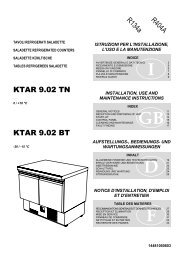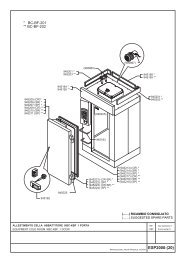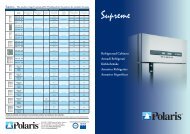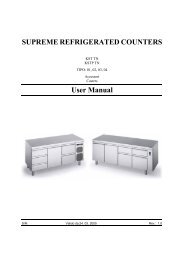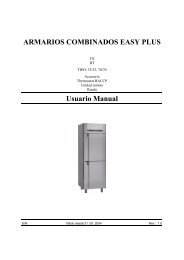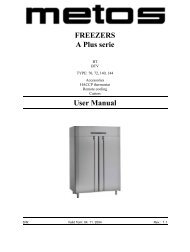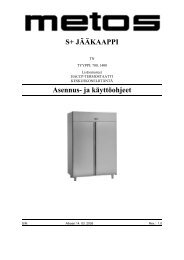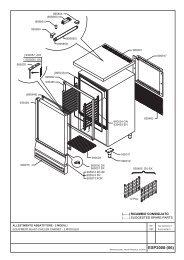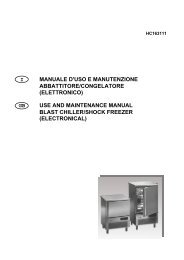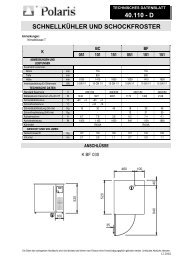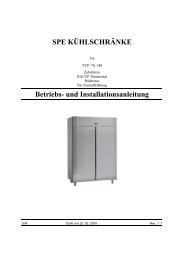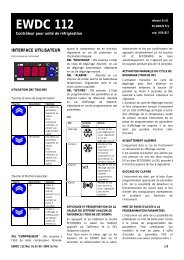SPE FREEZERS User Manual
SPE FREEZERS User Manual
SPE FREEZERS User Manual
Create successful ePaper yourself
Turn your PDF publications into a flip-book with our unique Google optimized e-Paper software.
3.5.2004 Rev. 1.0
3.5.2004 Rev.1. General information ..................................................................................... 11.1 Symbols used in the manual .......................................................................................... 11.2 Symbols used on the appliance ...................................................................................... 11.3 Checking correspondence between the appliance and the manual ............................... 22. Safety .............................................................................................................. 32.1 Using the appliance safely ............................................................................................. 32.2 Recommendations on how to best operate the appliance (2000/40/EC) ....................... 32.2.1 Installation tips ....................................................................................................... 42.3 Disposing of the appliance (environmental protection) ............................................... 43. Functional description .................................................................................. 53.1 Intended use .................................................................................................................. 53.2 Control panel ................................................................................................................. 64. Operating instructions ................................................................................. 74.1 Prior to use .................................................................................................................... 74.1.1 Preliminary checks ................................................................................................. 74.1.2 Start-up and checks ............................................................................................... 74.2 Operation ....................................................................................................................... 84.3 After-use care ............................................................................................................... 84.3.1 Cleaning ................................................................................................................. 84.3.2 Maintenance operations that may be carried out by the user ................................ 84.3.3 Maintenance operations to be performed by authorised technical support personnel94.3.4 Rating plate data .................................................................................................... 94.3.5 Idle periods ............................................................................................................ 95. Installation ................................................................................................... 105.1 General information ..................................................................................................... 105.2 Transport and storage .................................................................................................. 105.3 Unpacking the appliance ............................................................................................. 115.4 Installation ................................................................................................................... 115.4.1 Cleaning ............................................................................................................... 115.5 Electrical connections .................................................................................................. 115.6 First turn-on ................................................................................................................ 115.7 Connections for “Remote cooling” ............................................................................. 125.7.1 Electrical connections .......................................................................................... 125.7.2 Connecting refrigerant pipes ................................................................................ 12
3.5.2004 Rev.5.7.3 Suggestions .......................................................................................................... 126. Adjustment instructions ............................................................................. 136.1 Thermostat operation ................................................................................................... 136.1.1 Keyboard .............................................................................................................. 136.1.2 Display ................................................................................................................. 136.1.3 Setting the SETPOINT ........................................................................................ 146.1.4 Starting a manual defrost ..................................................................................... 146.2 Changing the light bulb ............................................................................................... 146.3 Attaching and detaching the grille support guide ........................................................ 147. Troubleshooting .......................................................................................... 158. Technical specifications .............................................................................. 17
General information3.5.2004 Rev. 1.01. General informationThis manual contains information on how to minimise environmental impact in compliancewith ECO-LABEL regulations (2000/40/EC).Read the instructions in this manual carefully, as they contain important information onhow to install, use and service the appliance safely, properly, and effectively.Keep this manual in a safe place for future reference by other users.This appliance should be installed following the instructions provided by the manufacturerand in compliance with all applicable local regulations. This appliance should be connectedto the power and water supply only by qualified personnel.All personnel in charge of using this appliance should be specifically trained in its operation.In the event of failure or malfunction, switch off the appliance. The periodic functionalchecks requested in this manual should be carried out according to the instructions. Havethe appliance serviced by a technically qualified person duly authorized by the manufacturerthat uses genuine spare parts. Never attempt to repair this appliance by yourself. Repairscarried out by unqualified people can cause damage.Failure to comply with the above may jeopardise the appliance’s safety.1.1 Symbols used in the manualThis symbol informs about a situation where a safety risk could be imminent. The instructionsprovided must be followed in order to prevent injury.This symbol informs about the right way to act in order to prevent bad results, damage tothe appliance, or hazardous situations.This symbol informs about tips and tricks that help the user to get the best possible performanceout of the appliance.This symbol informs about a function that needs to be taken into account when doing selfcontrol.1.2 Symbols used on the applianceThis symbol on a part warns the user that there are electrical terminals behind it. Therefore,the concerned part should only be removed by qualified personnel.1
General information3.5.2004 Rev. 1.01.3 Checking correspondence between the appliance and the manualThe rating plate of the appliance shows its serial number. If the manuals are missing, youmay order new ones from the manufacturer or your local representative. When orderingnew manuals it is essential to quote the serial number shown on the rating plate.Keep this manual as well as the wiring diagram with care, and put them at the operator’sdisposal for future reference.2
Safety3.5.2004 Rev. 1.02. Safety2.1 Using the appliance safelyRead the following directions and warnings carefully:2.2 Recommendations on how to best operate the appliance (2000/40/EC)Following the suggestions contained in this chapter will result in lower energy consumption.These appliances are designed for indoor use.Choosing a convenient installation location for the appliance is extremely important to ensureproper operation and energy savings; in fact, users who have the possibility of installingthe appliance in a non-heated or less-heated room can achieve significant energysavings.The best performance is obtained when room temperature ranges between +18°C (64°F)and +43°C (109°F) (Climate class T); +18°C (64°F) and +38°C (100°F) (Climate classST); +16°C (61°F) and +32°C (90°F) (Climate class ST); the rating plate found inside theappliance shows the climate class to which it belongs.If room temperature exceeds the values indicated by the climate class of this product,please follow the directions below: when room temperature falls below the minimum value,a proper storage temperature in the freezer compartment may not be ensured; therefore,we recommend that you use up all food contained in it as soon as possible.In order to achieve additional energy savings and ensure proper operation, we recommendthat you avoid opening the door/lid or holding it open more often or longer than necessary.It is important to let foods cool down prior to storing them in the appliance, because otherwisethey will produce steam which, in turn, favours frost build-up on the evaporator;in addition, it is important that the cool-down period is as short as possible (if possible,use blast chillers) for health and hygiene reasons.Avoid heavy frost build-up on the evaporator; if necessary, carry out additional manualdefrost cycles to melt away any frost build-up.Replace the door gasket if it is not working properly.It is useful to keep the condenser found in the appliance’s motor compartment and thespace under the refrigerator clean by removing any dust and cooking vapours.3
Safety3.5.2004 Rev. 1.02.2.1 Installation tipsCheck that the surface on which the appliance will rest is level and suitable to support itsweight.To ensure proper airflow and avoid any damage to the refrigeration circuit, allow a minimumside clearance of 50 mm (2 inches); do not place the appliance close to heat sources(such as ovens, radiators, etc.) or exposed to direct sunlight and provide suitable insulationfrom walls or floor if they transmit heat.If the appliance has been moved, wait for a while before switching it on again.2.3 Disposing of the appliance (environmental protection)Our appliances contain the refrigerant shown on the corresponding rating plate as perRegulation (EC) No. 2037/2000 of 29 June 2000; in addition, the appliance is composedof reusable or recyclable parts and materials. Therefore, at the end of its lifetime, the applianceshould be delivered to a specific disposal centre. The best method to ensure thatno one will remain trapped inside is to take off the door completely.The appliance must not be disposed of together with household waste and metal scrap.Absolutely avoid damaging the refrigeration circuit, particularly near the heat exchanger.4
Functional description3.5.2004 Rev. 1.03. Functional description3.1 Intended useThis appliance should only be used to store food and beverages. The manufacturer shallnot be held liable for the consequences resulting from unintended uses of this appliance.Do not store food in direct contact with the structure.Both the appliance’s construction features and the condensing unit’s capacity have beendesigned to store only pre-cooled products. Never place carbonated beverages into thelow-temperature compartment as they may explode. Never place liquids or hot food intothe appliance and do not fill lidded containers to the top.In all appliances there are surfaces subject to frosting. Depending on the model, frost maybe melted away either automatically (automatic defrost) or manually. Never attempt to removefrost using a pointed object because in this way you could irreparably damage theappliance.Do not use any mechanical device or other artificial means to accelerate the defrost process.The Manufacturer declines all responsibility, and the warranty shall be null and void, ifelectrical and/or mechanical alterations are made to the product.The warranty shall also be null and void if the product is tampered with or, in general, incase of alterations not expressly authorised and not made in compliance with the instructionsgiven herein.5
Functional description3.5.2004 Rev. 1.03.2 Control panelThe following components are found on the appliance’s front panel:Pic. 3.1 - Front Panel1. Main switch2. Temperature display / Electronic controller6
Operating instructions3.5.2004 Rev. 1.04. Operating instructions4.1 Prior to use4.1.1 Preliminary checksGeneral checksTo ensure proper operation:• Check that the appliance is well levelled. If necessary, adjust the mobile part of theadjustable feet until the appliance is perfectly level.• Check that all plastic protective film has been removed from outer surfaces.• Check that the inside has been cleaned with warm water and neutral soap.• Check that the appliance is positioned as far from heat sources as possible.• Check for free, unobstructed air circulation inside motor compartment.• Check that locking keys (if available) are out of children’s reach.Checking the electrical equipment• Check that the power network voltage and frequency rating matches the valuesshown on the appliance’s rating plate (item 6 in paragraph "Rating plate data").• Check that the screws fixing the wires to the electric components found in theboard are properly tightened (as vibration could have worked them loose duringhandling and transportation).• Make sure that a 16A-fuse has been fitted upstream of the power socket (outlet).• Turn OFF the general switch to which the power cord plug will be connected.• Check that the power socket (outlet) is compatible with the type of plug the appliance has.If necessary, have the plug replaced with a suitable one by a professionally qualified technician,who will be in charge of checking that the gauge of socket (outlet) wires is suitablefor the appliance’s power input. Check that the plug is correctly plugged in.4.1.2 Start-up and checksOnce you have carried out all the above steps carefully, you are ready to start up the appliance:• Turn ON the general switch to which the power supply cord plug is connected.• Turn ON the appliance’s switch.• To change the SETPOINT, refer to paragraph "Thermostat operation" in chapter"Adjustment instructions".7
Operating instructions3.5.2004 Rev. 1.04.2 Operation4.3 After-use careProper storage of foodstuffs is a relevant factor in the safe and sanitary production of food;in addition, it improves the efficiency of foodservice activities and positively affects energyconsumption. Follow the directions below to obtain the highest performance possibleout of your appliance.Products should be placed into the appliance in such a way as to allow unobstructed airflow.Always leave some free space between the products and prevent them from comingin contact with the walls. If needed, adjust the distance between shelves. Products shouldalways be stored on the shelves; do not place any products on the cabinet’s bottom.4.3.1 CleaningHow often you will need to clean the appliance depends largely on how often you use it.Analyze the use and schedule the required cleaning operations.To clean the appliance’s inside and outside, use a neutral or slightly alkaline detergent.We recommend that you clean the inside with a disinfectant every once in a while. Impuritiesmay be removed using a damp cloth. Removing the shelves makes cleaning the insideeasier.Prevent water from coming in contact with the electrical components. Using a pressurisedjet of water to clean the appliance is forbidden. Never use metal objects to clean the appliance,as they could damage it.4.3.2 Maintenance operations that may be carried out by the userUnder normal conditions of use the appliance only requires a minimum of maintenance.The user can carry out the following operations:• Cleaning the inside and outside every day or as often as needed.• Cleaning the condenser at least twice a year or more often if used in a dusty environment.Before cleaning the condenser, turn the appliance off using the mainswitch and disconnect the power cord from the power socket (outlet). Use a vacuumcleaner or a soft brush. When brushing the condenser, exercise great care so asto avoid damaging the aluminium grid.• Check that the condensate drain hose is not clogged. If needed, clean it. Possiblemalfunctions due to a clogged drain may not be attributed to the manufacturer.• Check that the fan is properly fixed to its frame.• Check for fan unbalancing, evidenced by abnormal vibration or noise, thoroughly.• Check the power cord connecting the appliance to the wall socket (outlet) for cuts,cracks, or alterations which might compromise its insulation. If the power cordneeds servicing, contact your nearest technical support centre.8
Operating instructions3.5.2004 Rev. 1.04.3.3 Maintenance operations to be performed by authorised technical support personnelAny maintenance operations not mentioned in the above paragraphs, should be performedby authorised technical support personnel only. The need to perform maintenance operationsdepends largely on the external conditions and how often the appliance is used.For further information, contact your local representative. Identifying the appliance correctlyis useful when ordering spare parts or requesting maintenance or repair operations. The appliance’smodel and serial number are shown on the rating plate found inside the appliance.4.3.4 Rating plate dataPic. 4.1 - Rating plate1. Climate class2. Net capacity3. Model4. Code5. Serial Number6. Voltage7. Power input8. Defrost heater9. Power10. Refrigerant11. Year of Manufacture12. Lowest and highest pressure4.3.5 Idle periodsFollow the precautions below if the appliance will be left idle for some time:• Unplug the appliance from the wall socket (outlet);• Remove all foodstuffs from the appliance;• Defrost it and clean the inside;• Leave the door partly open to favour air circulation inside the cabinet and preventunpleasant smells from forming.• Store the appliance in such a way as to avoid that anyone can remain trapped inside.9
Installation3.5.2004 Rev. 1.05. Installation5.1 General information5.2 Transport and storageEnsure that installation is performed according to the instructions given under chapter"Recommendations on how to best operate the appliance (2000/40/EC)", "Installationtips". We remind you that insufficient airflow will certainly result in appliance malfunctionor damage.Once the appliance has been installed, ensure that it is not resting on the power cord.In the event of damage, the power cord should only be replaced by qualified personnelwith a special cable or cable assembly available from the manufacturer.Ensure compliance with all local safety rules in force at the time of installation.Prior to plugging in the appliance, ensure that the power distribution network ratingsmatch the values shown on the appliance’s rating plate.It is absolutely necessary that the appliance be connected to an effective earth (ground)connection. To this end, the power cord plug is equipped with a grounding contact. If thepower socket (outlet) of the system is not grounded (earthed), connect the appliance to aseparate grounding (earthing) system in compliance with applicable regulations in force.Ask for a qualified technician’s advice.The manufacturer declines all responsibility in case of non-compliance with this accidentpreventionrule.You must always be able to disconnect the appliance from power supply; therefore, oncethe appliance has been installed the power socket (outlet) should be easily accessible.If possible, do not unpack the appliance until it is placed near the final installation site. Donot tip it over.If the appliance has been tipped over, wait for a while until oil settles down again.The appliance should always be stored in sheltered areas.If the appliance was stored in a cold place, thus causing the temperature of the refrigerationunit to fall below 0°C (32°F), prior to start using the appliance keep it at room temperaturefor at least one hour so that the refrigeration unit will warm up to +16°C (61°F).Turning on the appliance when temperature is excessively low may result in compressormalfunction.10
Installation3.5.2004 Rev. 1.05.3 Unpacking the appliance5.4 InstallationUnpack the appliance and check for transport damage. Remove the protective film fromthe appliance’s body.Packing materials (plastic bags, polystyrene foam, nails, etc.) should be kept out of children’sreach as they are potential sources of hazard, and they should be properly recycledin compliance with local regulations in force.Place the appliance in its final installation site.When lifting the appliance with a suitable mechanical device, ensure that the structure atthe base is undamaged.Level the appliance using its adjustable feet. Use a level, if needed. The maximum permissibledeviation from the horizontal plane is +/-0.5 degrees. All four feet should be restingon the floor. This will ensure proper door operation.5.4.1 Cleaning5.5 Electrical connectionsPrior to use, clean the inside, the shelves and the outside with a cloth and wipe dry. Toclean use a neutral or slightly alkaline detergent.5.6 First turn-onThe appliance may be switched on three hours after installation. Plug the appliance into agrounded outlet (earthed socket). To do so, you will need to have a power outlet (socket)with a built-in 16A-fuse fitted upstream of the system. Check that power supply voltagematches the value shown on the appliance’s rating plate.Check that a circuit breaker switch having a contact gap of at least 3 mm is fitted upstreamof the power socket (outlet).Turn on the appliance using the main switch. After 1 minute, the compressor will start cyclinguntil internal temperature reaches the factory-set value. Do not load the applianceuntil the set temperature value has been reached. If you need to change any factory-set parameters,please read the instructions given under chapter "Adjustment instructions".11
Installation3.5.2004 Rev. 1.05.7 Connections for “Remote cooling”5.7.1 Electrical connectionsThe version with a control panel incorporates an electronic thermostat, switches, warninglights and indicators according to what has been specified under the chapter 3.2 “Construction”section. In this case the unit must be connected to a motor-driven condensingunit.Connect to terminals M on the compressor and on the electric condenser fan.5.7.2 Connecting refrigerant pipesSuction pipesLay down the suction line according to the established layout making sure that the numberof elbows and vertical sections where the refrigerant flows upward is limited to the veryminimum. Weld the suction line to the appliance exits jutting out of the side, provided forthis purpose. The suction pipe is generally to be distinguished from the liquid line by itsdiameter: it is the larger of them. Repeat the operation on the condensing unit. The verticalsections of the suction pipe shall be equipped with a trap and counter- trap to make oiltrapping easier and prevent it from flowing back to the evaporator when the compressoris off due to the thermostatic control.Please bear in mind that the only method applicable to vertical pipe sections where therefrigerant flows upward to make sure the oil returns to the compressor and prevent iffrom seizing due to insufficient lubrication, consists in “pulling” the oil by exploiting gasspeed.Liquid lineLay the liquid line pipes according to the established layout making sure that the numberof elbows and vertical sections where the refrigerant flows upward is limited to the veryminimum. Braze the liquid line pipe to the appliance outlet pipe located where the especiallyprovided protruding section is. The liquid line pipe can generally be distinguishedfrom the suction pipe by its diameter: it is the smaller one. Repeat the operation for thecondensing unit.5.7.3 Suggestions• SLANT: the horizontal sections of the suction pipes shall have a 0.5% slant towardsthe compressor to ensure oil back flow.• ELBOWS: to reduce pressure drops to a minimum, include as few elbows in yourline as possible and if you do, use large radius elbows only.• THERMAL INSULATION: the liquid line shall be insulated if exposed to the sunor if passing through areas where temperature is higher than condenser outlet temperatur12
Adjustment instructions3.5.2004 Rev. 1.06. Adjustment instructions6.1 Thermostat operation6.1.1 KeyboardThermostat ID 974 (BT)Arrow UP key (P1): Scrolls through the menu items; increases values, starts manual defrost.Arrow DOWN key (P2): Scrolls through the menu items; decreases values.FNC (P3): Exit function.SET (P4): Accesses the setpoint; accesses the menus; confirms commands.6.1.2 DisplaySymbols on the front panelLED L1 signals an alarm; blinking means that the alarm is in silent mode.LED L2 indicates that a defrost cycle is in progress; blinking means that a manual defrostcycle is in progress.LED L3 indicates that the compressor is on; blinking means that a delay time, a safety delaytime or a compressor shutdown is in progress.LED L4 (ID 974 only) indicates that the fan is on.13
Adjustment instructions3.5.2004 Rev. 1.06.1.3 Setting the SETPOINT1. To access the "Machine status" menu, press and immediately release the SET key.The label of the "Set" folder will appear;2. To display it, press SET again. The SETPOINT value will appear on the display.3. To change the SETPOINT value, use the arrow up and down keys within 15 seconds.6.1.4 Starting a manual defrost6.2 Changing the light bulbTo start a manual defrost cycle, press and hold down the arrow up key (P1) for 5 seconds.If the conditions required to start a defrost are not met (for example, evaporator sensortemperature is higher than defrost end temperature), the display will blink three times towarn the user that the operation will not be carried out.To change the light bulb perform the following steps (the voltage of the light bulb isshown on the adhesive label):• Switch off the appliance and disconnect the power cord;• Open the appliance door;• Remove the protective glass shield from the light;• Unscrew the light bulb located in the instrument panel and replace it with an identicalcomponent of the same voltage;• Refit the glass shield.6.3 Attaching and detaching the grille support guideCarry out the following steps to attach the grille support guides correctly:Push the guide downwards (2) and then inwards (3) in the chosen position of the rack.Pic. 6.3Perform the operation in reverse order to detach the guide.14
Troubleshooting3.5.2004 Rev. 1.07. TroubleshootingIn the event of malfunction, check the list below to see if it is possible to restore the applianceto working condition without needing to call the technical support service. Forfurther information, please contact your nearest technical support centre.TROUBLE POSSIBLE CAUSE REMEDYSENSOR(S) FAILURECOMPRESSORNOT RESTARTCOMPRESSORDOM STOPSWILLSEL-FROSTED COMPRES-SOR SHELLNOISY APPLIANCEOVERFLOWING OFSELF-EVAPORATINGCONDENSATE TRAYSensor disconnectedSensor damagedElectrical equipment of the compressor(relay, motor protection and condenser) isfaulty.Compressor has a winding open or shorted,or there is an earth (ground) faultRoom temperature is too highRefrigerated cabinet condenser is dirtyLow refrigerant chargeDoor gaskets do not ensure proper sealFrost build-up on the evaporatorExcess refrigerant chargeFrost build-up on the evaporatorEvaporator motor fan(s) damagedLoose screwsVibrating pipesHot or high-water content foodstuffs arebeing introduced into the appliance too oftenDoors and/or drawers are opened too oftenConnect sensor to the thermostat againCall an authorised technical support centre tohave it replacedCall an authorised technical support centre tohave the concerned component replacedCall an authorised technical support centre tohave the compressor replacedEnsure proper ventilation to the roomCheck it on a regular basis and clean it thoroughlyCall an authorised technical support centre tofind and repair any leaks and to recharge thecompressor with refrigerant.Call an authorised technical support centre toperform the necessary replacementDo not place hot or high water content foodstuffsinto the appliance and, if needed, perform a manualdefrost cycle.Call an authorised technical support centreDo not place hot or high water content foodstuffsinto the appliance and, if needed, perform a manualdefrost cycle.Call an authorised technical support centre toperform the necessary replacementCheck that all screws are tightened and tightenthem if needed.Check that they are well fixed and, if needed,space adjoining pipes out so that they do not collide.Do not introduce hot or high water content foodstuffsinto the appliance.Pay attention to the conditions of use of your appliance.15
Troubleshooting3.5.2004 Rev. 1.016
Technical specifications3.5.2004 Rev. 1.0Motorised refrigeration circuit diagramDescription1 Compressor2 Condenser3 Filter drier dirty4 Capillary tube5 Evaporator18
Technical specifications3.5.2004 Rev. 1.0Refrigeration circuit diagram of remote-refrigerated appliancesDescription1 Compressor2 Condenser3 Filter drier dirty4 Valve5 Evaporator6 Will be borne by the installer19
Technical specifications3.5.2004 Rev. 1.0DescrizioneDescrizioneHL1 CABINET LIGHTING R3 DRAIN HEATERKA1 FAN AND LIGHTING RELAY SQ DOOR SWITCHKM POWER RELAY ST1 ELECTRONIC CABINET THERMOSTATM1 MOTOR COMPRESSOR YV2 BY-PASS SOLENOID VALVEM2 CONDENSER MOTOR FAN 1 FOR 120/140 VERSION ONLYM3 CABINET MOTOR FAN 11 ONLY ON REQUESTQM1 MAIN SWITCH 14AVAILABLE ON REMOTE-REFRIGERATEDUNITS ONLYR DEFROST HEATER 15NOT AVAILABLE ON REMOTEREFRIGER-ATED UNITSR1 CONDENSATE TRAY HEATER 16NOT AVAILABLE ON GLASS DOOR MOD-ELSR2 DOOR FRAME HEATER21
Technical specifications3.5.2004 Rev. 1.0Installation drawing BT, 14024
Technical specifications3.5.2004 Rev. 1.0Installation drawing BT, 14425
Technical specifications3.5.2004 Rev. 1.0Item Type SpecificationNominal gross volume 70,72 600 LtNominal gross volume 140,144 1300 LtPackage dimensions WxDxH 70,72 760 x 880 x 2230Package dimensions WxDxH 140,144 1460 x 880 x 2230Volume with package 70,72 1,5 m3Volume with package 140,144 2,9 m3Total weight 70,72 145 KgTotal weight 140,144 235 KgVoltage 230/1/50Power of compressor 70,72 300 W (CECOMAF -30+55)Working temperature 140,144 566 W (CECOMAF -30+55)Refrigeration system -21 / -18 °CType of defrostCapillaryDefrosts per day / Defrost duration time (min)VentilatedCurrent absorbed during operationElectricalMax current absorbed4,8 / 30 min.Power absorbed during operation 70,72 3,8 APower absorbed during operation 140,144 4,4 APower absorbed during operation16 AMax power absorbed 70,72 630 WPower consumption 140,144 1000 WPower consumptionR404ARefrigerant type 70,72 410 gQuantity of refrigerant 140,144 305 gHeat emitted 70,72 560 WHeat emitted 140,144 1020 WAir capacity with filter 70,72 420 m3/h140,144 420 m3/h26



